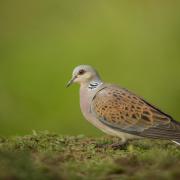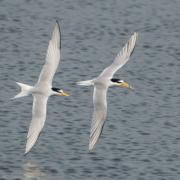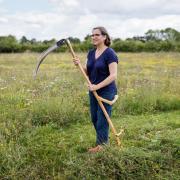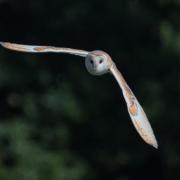Suffolk's summer is now but a fast-fading memory though the autumn migration season is a more than adequate replacement - and it's sure to get the birdwatcher's pulses racing says John Grant
Suffolk’s summer is now but a fast-fading memory though the autumn migration season is a more than adequate replacement - and it’s sure to get the birdwatcher’s pulses racing says John Grant
I used to hate September. Round about the end of the first week my boyhood spirits would be low. Very low. After a summer of long days in the field, immersed in birds, butterflies and all the other magical things wildlife gave me, something dark and sinister was fast approaching. School.It wasn’t that I hated school as such. Enduring uninspiring teachers and the drudgery of soaking up stuff – useless stuff – simply for the purpose of trying to get through exams was bad enough. But what I really resented was that all the time I was at school I was unable to get out into the countryside and experience the changing of the seasons.What made it worse, I could actually see some of the wonderful wildlife-rich areas I loved so much from the windows of many of my tower-block classrooms. I used to stare out of those windows while some truly appalling, unforgivably lazy teacher droned on – often simply reading from a textbook without the slightest hint of enthusiasm for the subject – and I used to daydream. My mind was mainly on migration.At the very time the miracle that is bird migration was really getting into full swing during September, I was stuck in a classroom letting such riveting and, for me, monumentally useless concepts as algebra, logarithms, cosines, tangents and the like pass into one ear and out the other. All the while I was somewhere else. Out amongst the birds.Now, free from the clawing shackles of such intrinsically dull education, which I have subsequently deeply resented for decades, September in Suffolk is something to be savoured. And savour it I will. And savour it you should too for it is a wondrous, wondrous time indeed.We may experience an ‘Indian summer’ from time to time – and increasingly, so it seems, with climate change clearly kicking in – but in September there is usually more than a hint of autumn in the air. Autumn, for me, means birds – birds from afar, birds from the most outlandish of corners of the globe all turning up on the doorstep. Right here. Right now. In Suffolk. Inspiring, or what?You can sit in a shelter that’s snuggled cosily away just above Southwold’s lower promenade, just south of the pier, and, mostly when the wind is up and the white horses are racing, see sooty shearwaters passing by that have been at sea for months after emerging from a burrow on some far-flung island in the southern hemisphere. They breed on the islands around the very southern tip of South America and in the southern winter they are up in the North Atlantic, off eastern North America, before heading east in a great oceanic arc. By September they are off western European coasts and some reach the North Sea. Just think. The transequatorial ‘sooty’ careering past Southwold with an exhilarating ease will, come ‘our’ winter, be back on those South American islands. It leaves me speechless.Sooty shearwater is but one example. There are plenty more, thankfully. Lines of gannets, other shearwaters, skuas, perhaps a petrel or two, can all thrill us in the stormier conditions.
in Britain to witness the wonders of bird migration.At this time of the year, the nation’s army of birders are obsessed with weather forecasts. They hang on the forecaster’s every word,
And September is a month in which virtually anything can turn up, and frequently does. And not just in the seabird department. It is one of the rarity-hunter’s favourite months – from north, south, east and west a procession of species calls in to Suffolk, it being one of the best counties in Britain to witness the wonders of bird migration.At this time of the year, the nation’s army of birders are obsessed with weather forecasts. They hang on the forecaster’s every word, in Suffolk praying for the magic words: “The winds will be east and it will be a claggy, overcast day with rain just before dawn.” That is guaranteed to set the birder’s pulses racing, for it is ‘fall’ conditions on the Suffolk coast. A landfall of migrant birds is likely to take place along our shores and you just have to get out there to enjoy it.Of course, there are not so many birds in northern Europe as there used to be. The way modern man lives has seen to that alright. We are hardly likely to see a repeat of the events that took place on the coastal strip between Lowestoft and Minsmere on September 3, 1965. That date has gone down in the annals of ornithology – the biggest ‘fall’ of migratory birds ever recorded in Britain.The weather conditions conspired to rain birds down that day – a deluge of more than half a million individuals of 78 species, including 250,000 common redstarts, 100,000 northern wheatears, tens of thousands of pied flycatchers, hundreds of wrynecks and 60 bluethroats.We might never see such a spectacle again, and those who were not around to witness it can only try to imagine how the lucky observers must have felt. But we can see smaller ‘falls’ and still get a big, big buzz out of them.While looking to the skies and the seas, of course, we are missing what the plants are telling us about the changing of the season, so let our old friend Peter Lawson explain. “On urban fences and hedges the large bindweed with its huge, pure white bell-shaped flowers can make a spectacular show in late summer and if it was rare, and not considered a weed, would make a popular garden plant.“Most road verges get one cut in May, so by September they can again be colourful with wild flowers. Purple knapweed and yellow toadflax are often abundant, and are interspersed with a variety of the orange dandelion-like heads of hawksbeards and hawkbits, along with common catsear, flowering for a second time.“Once the cereal harvest is over, vegetation quickly returns to any uncultivated stubble, predominantly with the white mayweeds which have daisy-like flower heads and ferny foliage. Among others there are occasionally plants of cornmint, identified by its obvious smell, and scarlet pimpernel (and if you are very lucky, its rare blue form). “Following a hot summer the large white trumpets of thorn apple can sometimes be seen on sandy soils. The whole plant is poisonous, including its ‘conker’ like fruits.“Early in the month do go to the Suffolk Wildlife Trusts’ Martin’s Meadow reserve at Monewden, near Otley, to see hundreds of ‘naked ladies.’ These pink crocus-like blooms, correctly known as meadow saffron, are our only wild colchicum and come before the leaves, which do not appear until spring.“Naked ladies” out in the Suffolk countryside. Now there’s a thought. Well, I did say that September was to be savoured….
NOW'S THE TIME TO SEE...
Red-backed shrike: It’s always a bitter-sweet moment when you see this species in Suffolk nowadays. The thrill of seeing what is now a scarce but annual passage migrant is tinged with the knowledge that this handsome bird used to breed fairly commonly in the county.Its downfall has been swift and complete. It hasn't bred with us for several years after the heyday of the immediate post-war period and the dwindling to zero in the 1980s.Several theories have been put forward for the decline but it is most likely a combination of factors including climatic change, a general lack of insect life thanks to years of incessant pesticide use in the wider countryside, destruction of marginal habitats and – just to finish off the litany of disaster – egg-collecting in the species’ final decades with us.


























